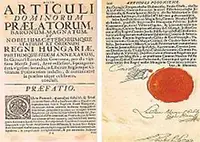Maria Theresa: Holy Roman Empress
Part 1: The Throne in Doubt Maria Theresa was Holy Roman Empress for four decades in the 18th Century, surviving a devastating war over her succession and ruling over a period of great reform. 
She was born on May 13, 1717, in Vienna. Her father was the Holy Roman Emperor Charles VI, and her mother was Elisabeth Christine of Brunswick-Wolfenbüttel. Charles VI and Elisabeth Christine had married in 1708. At that time, Charles's elder brother, Joseph, was the Holy Roman Emperor. Joseph died in 1711. He had no son, and so Charles was next in line to the throne. Joseph had had a son, Leopold Joseph, in 1700, but the boy died before seeing his first birthday. Joseph had two surviving daughters, Maria Joseph (1699) and Maria Amalia (1701). Since by 1711 Charles VI was the only surviving male member of the House of Habsburg, he was very much concerned with maintaining the Habsburg line of succession. The Holy Roman Empire began with the reign of Charlemagne and so was, at its origins, a Frankish creation. Part of the legal tradition of the Empire that persisted was Salic Law, which in the case of succession to things like lands, titles, and thrones, governed thus, according to Title 59, Point 6: "Of Salic land no portion of the inheritance shall come to a woman." So the private property that a man's sister could otherwise inherit did not include whatever land that man might own. Through the years, authorities interpreted this to include the kingship, so that a king who had a daughter but not a son could not leave the kingdom to his daughter and, therefore, have her be queen after him. 
That was the situation that Charles VI confronted when his brother Leopold died, leaving no male heir. In 1713, Charles VI issued the Pragmatic Sanction, declaring by imperial decree that the imperial throne could be occupied by a female heir. Charles and Leopold had made a Mutual Pact of Succession before the latter died, and so Charles was comfortable with having Leopold's elder daughter, Maria Josepha, succeed him on the imperial throne. The other governments of Europe took their time in accepting the Pragmatic Sanction; Charles usually succeeded in this regard by making concessions as a quid pro quo. For example, the 1738 Treaty of Vienna, which ended the War of the Polish Succession, also handed over the Duchy of Lorraine to France and gave the kingdoms of Naples and Sicily to Spain, in exchange for those two powers' recognizing Charles's rights of succession as declared in the Pragmatic Sanction. To get the support of England and the Dutch Republic, Charles had to shutter the Ostend Company, a profitable trading enterprise that he had started. The Polish war, and one with Russia against Turkey, came about partly because of this succession situation. This is the world in which Maria Theresa grew up. She was born six months after the death of Charles's only son, Leopold Johann. Charles had thought that his fondest wish had come true, but the infant lived for only seven months. Maria Theresa became the heir apparent, supplanting her cousin Maria Josepha. She learned Latin and studied the arts, taking a particular interest in opera. 
Maria Theresa's parents had more children; both were girls–Maria Anna (1718) and Maria Amalia (1724). All were reared and educated as if they were to be married to monarchs, not monarchs themselves. Thus, even though Charles VI (right) had gone to tremendous pains to ensure that one (if not all) of his daughters would succeed him, he did not then provide any of them with the training and experience in statecraft that would have been part and parcel of the upbringing of a male heir. Maria Theresa did attend council meetings beginning when she was 14, but her father did not take her in to his confidence as he would have done with a son. 
Charles was, however, quite interested in securing an influential husband for his eldest daughter. After considering a number of eligible candidates, he chose Leopold Clement. He died, and Charles named instead his younger brother, Francis Stephen of Lorraine (left), who stood to inherit the Grand Duchy of Tuscany as well as the rich throne of Lorraine. Maria Theresa and Francis Stephen married on Feb. 12, 1736. Francis Stephen did inherit the Lorraine throne, in 1729, and the Tuscan throne, in 1737. The following year, Charles VI suffered a series of setbacks in his war with Turkey. One result of these was a large-scale riot in Vienna. Both the war with Poland and the war with Turkey ended, and Charles focused on stabilizing his empire. His army was in tatters, as was his treasury. This was the state of things when Charles died, on Oct. 20, 1740. Maria Theresa was then to inherit the imperial throne. 
Technically, most of the great powers of Europe had accepted the Pragmatic Sanction. Once it became a reality, however, things were different. King Charles Emmanuel III of Sardinia did finally recognize Maria Theresa as Holy Roman Empress, but others went in the opposite direction. The result was the War of the Austrian Succession. Frederick II of Prussia invaded the Duchy of Silesia, touching off the First Silesian War. Frederick and Prussia won a quick victory when the fighting resumed, in April 1741, and France entered the war on the side of Prussia. French troops drove toward Vienna but were unable to take it. They did take Prague, however. The Elector of Bavaria, seeing opportunity, declared himself Archduke of Austria and had himself crowned the Holy Roman Emperor Charles VII in January 1742. Subsequent victories by France and Prussia convinced Maria Theresa to sue for peace. The war continued, with England joining the fray in support of the Empire. Eventually, the Dutch Republic and Saxony joined Austria and England, forming the Quadruple Alliance, to fight France. The 1745 Treaty of Dresden ended the main fighting. In exchange for allowing Frederick II to annex Silesia, Maria Theresa won the right to be recognized as Empress and for her husband to be recognized as emperor consort. They had been crowned as such on Sept. 13, 1745. The fighting continued, with imperial troops struggling against France and Spain in Italy. A final treaty that ended all fighting was signed at Aix-la-Chappelle on Oct. 18, 1748. Next page > The Throne Secured > Page 1, 2 |
|
Social Studies for Kids
copyright 2002–2025
David White




